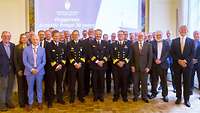Akustische Signatur – Messung unter dem Meer
Equipment, Information Technology and In-Service Support- Date:
- Place:
- Heggernes
- Reading time:
- 4 MIN


The acoustic signature of a ship is unique – almost like a person’s handwriting. In Heggernes near Bergen, Norway, the Bundeswehr, together with the Norwegian and Dutch military, operates a measuring site that can pick up these signatures underwater. There are only a few such sites in the world. In June, it celebrated its 30th anniversary.

Measuring the acoustic signals of submarines is one of the main tasks of the measurement teams
Bundeswehr/Tom KistenmacherWho is approaching in the open sea? This is what the international team behind the acoustic deep water measuring site is concerned with. The team’s task is to measure hydroacoustic signatures of ships, boats and, especially, submarines. Here’s why: "The acoustic signature of a ship serves as a clear identifier," Stefan S. explains. He works at the Bundeswehr Technical Centre for Ships and Naval Weapons, Maritime Technology and Research (WTDWehrtechnische Dienststelle 71) in Eckernförde, Schleswig-Holstein, and is responsible for coordinating the German part of the cooperation between the three participating nations.
In practice, the measurements are carried out, on the one hand, during acceptance of new ship construction projects such as submarines and frigates; on the other hand, they are performed for control purposes in the in-service use phase of ships and boats. The measured data is analyzed and provided to the units for further threat assessment. Since 1994, Norway, the Netherlands and Germany have organized and operated the measuring site on the basis of a Memorandum of Understanding.
There is a simple reason why the measuring site is located in Norway: Neither Germany nor the Netherlands have access within their European territorial waters to water depths great enough to measure submarines at their operational depth. In Norway, however, acoustic underwater conditions are ideal.
It is not only the technical equipment of the Heggernes station and the measurement configuration of the sensors deep under water that are unique. The sensor system is located in a Norwegian fjord that boasts a water depth of 385 meters. It is made up of three movable sensor chains that can operate in the depth – each equipped with three microphones for underwater use, so-called hydrophones – 100 meters apart from each other.

Optimal conditions: The measuring site is located in the middle of a Norwegian fjord
Bundeswehr/Stefan SchälSea traffic through the fjord is protected, meaning it can be largely regulated, which, in turn, results in minimized background noise. And, what is more, harsh weather and sea conditions are naturally mitigated within the fjord.
It is also unique that such a measuring site is jointly operated by three nations. They do not only share all effort and costs and ensure better utilization of the infrastructure; they first and foremost bring together all of their individual competences, which is particularly valuable. "In general, each nation has its own responsibilities," Stefan S. says. Norway, for example, is responsible for the on-site infrastructure – both above and below water. Germany and the Netherlands, on the other hand, are responsible for the lab measuring technology and the associated ITInformationstechnik.
"At the moment, there is actually only one person permanently on site," Stefan S. explains. If measurements are to be taken, the measurement team of the associated unit will travel to the site, with the number of persons depending on the extent of the planned measurement. For safety reasons, however, at least one Norwegian person is always present on site, ensuring that communication is possible at any time should ships or boats be located in the vicinity of the measuring site or wish to pass through the relevant area.

A deep water measuring site with three movable sensors that can operate in the depth: hydrophones, underwater transmitters and pressure sensors.
BundeswehrThe cooperation is essentially governed by two bodies made up of representatives of all three nations. There is the expert group, which is responsible for the operation, maintenance and further development of the measuring site, and then there is the steering committee, which has oversight over the finances and performs overall management tasks.
At the anniversary event in Norway, representatives from Germany, Norway and the Netherlands celebrated 30 years of cooperation; a cooperation that is to continue in the future. Admiral Andreas Czerwinski attended the ceremony for Germany, among others, as representative of the Federal Office of Bundeswehr Equipment, Information Technology and In-Service Support (BAAINBwBundesamt für Ausrüstung, Informationstechnik und Nutzung der Bundeswehr).
Continuous smooth operation of the measuring site is essential, especially in light of the upcoming joint naval projects for which detailed knowledge about the participants’ acoustic signatures is indispensable.

Cross-national celebration: In the opening panel discussion on the 30th anniversary, the representatives of the three countries unanimously emphasized the importance and necessity of the measuring station
Line Lien, NORMeasuring procedure for German Navy ships and boats|The hydroacoustic measurement will be scheduled once WTDWehrtechnische Dienststelle 71 has been notified of the need for such measurements. After the date has been confirmed, the Norwegian side will announce the measurement event via shipping communications to ensure that non-participating ships use other waterways as far as possible. A Norwegian employee working from within the measuring facility will pilot the remaining ships past the measuring site; this is to ensure that there will be no major restrictions once the measurement is under way. Immediately before the measurement starts, employees of WTDWehrtechnische Dienststelle 71 will install a tracking GPSGlobal Positioning System system capable of telemetry transmission, i.e. transmission of measured values from an onboard sensor to the measuring facility. One employee will remain on board for communication purposes. At the same time, the measurement program will be handed over and the procedure will be discussed with the ship's command. The aim is to take into account current information on the test range, the required operating condition and the additional configurations requested by the ship's command.
by Sarah Stein und Stefan Schäl